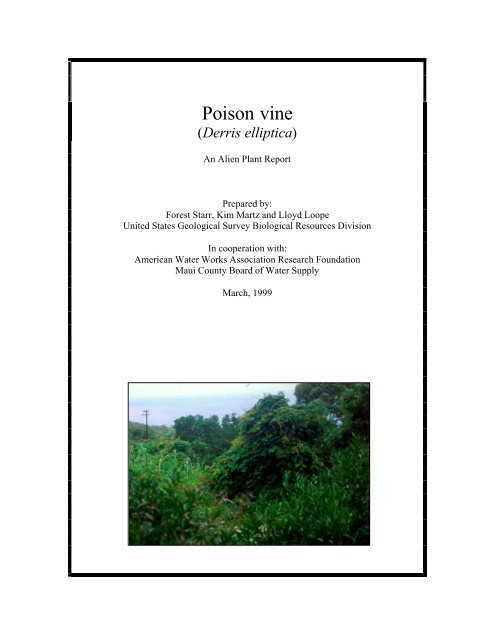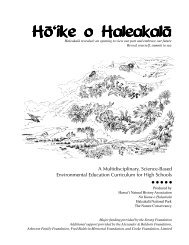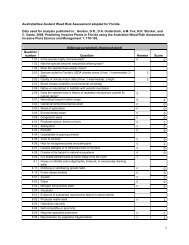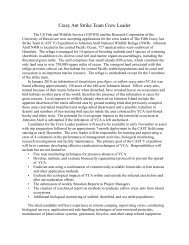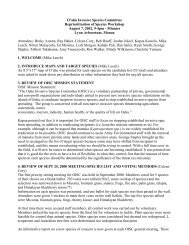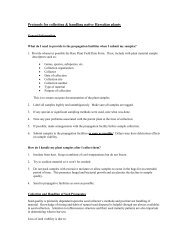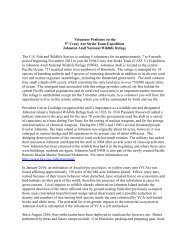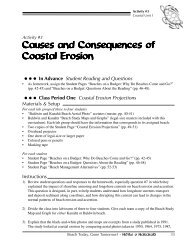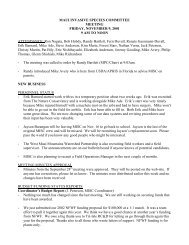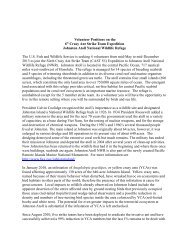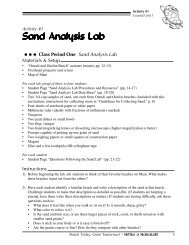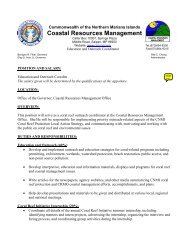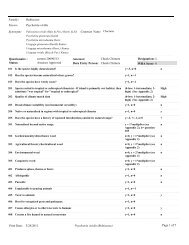Poison vine (Derris elliptica) - Hawaiian Ecosystems at Risk project
Poison vine (Derris elliptica) - Hawaiian Ecosystems at Risk project
Poison vine (Derris elliptica) - Hawaiian Ecosystems at Risk project
Create successful ePaper yourself
Turn your PDF publications into a flip-book with our unique Google optimized e-Paper software.
<strong>Poison</strong> <strong>vine</strong><br />
(<strong>Derris</strong> <strong>elliptica</strong>)<br />
An Alien Plant Report<br />
Prepared by:<br />
Forest Starr, Kim Martz and Lloyd Loope<br />
United St<strong>at</strong>es Geological Survey Biological Resources Division<br />
In cooper<strong>at</strong>ion with:<br />
American W<strong>at</strong>er Works Associ<strong>at</strong>ion Research Found<strong>at</strong>ion<br />
Maui County Board of W<strong>at</strong>er Supply<br />
March, 1999
<strong>Poison</strong> <strong>vine</strong><br />
(<strong>Derris</strong> <strong>elliptica</strong>)<br />
Wh<strong>at</strong> is <strong>Poison</strong> <strong>vine</strong>? Why is it bad?<br />
<strong>Poison</strong> <strong>vine</strong> is a climbing, woody, <strong>vine</strong> th<strong>at</strong> forms a dense canopy, and smothers<br />
veget<strong>at</strong>ion, fences, forests, pastures, and farm land. On Maui, poison <strong>vine</strong> is currently<br />
known to be restricted to a few acres in Nahiku.<br />
Wh<strong>at</strong> should you do if you see this plant in areas other than Nahiku?<br />
1. Call the Hawaii <strong>Ecosystems</strong> <strong>at</strong> <strong>Risk</strong> (HEAR) <strong>project</strong> <strong>at</strong> 572-4418.<br />
2. Dig out the root of the <strong>vine</strong>, if possible. Otherwise, cut the <strong>vine</strong> near the root of the<br />
plant, and tre<strong>at</strong> with an herbicide.<br />
3. For more inform<strong>at</strong>ion or additional copies of this flyer, call 572-4418 or websurf to<br />
www.hear.org.<br />
You can help keep Maui no ka oi.<br />
United St<strong>at</strong>es Geological Survey<br />
Maui County<br />
Biological Resources Division<br />
Board of W<strong>at</strong>er Supply<br />
<strong>Poison</strong> <strong>vine</strong> (<strong>Derris</strong> <strong>elliptica</strong>) 2<br />
American W<strong>at</strong>er Works Associ<strong>at</strong>ion<br />
Research Found<strong>at</strong>ion
<strong>Poison</strong> <strong>vine</strong><br />
(<strong>Derris</strong> <strong>elliptica</strong>)<br />
Overview: <strong>Poison</strong> <strong>vine</strong> is a large climber th<strong>at</strong> is mainly cultiv<strong>at</strong>ed in the tropics for its<br />
roots, a source of a valuable insecticide (Rotenone). It is known to be invasive in Fiji and<br />
western Polynesia. On Maui, poison <strong>vine</strong> is known from just one loc<strong>at</strong>ion, where it is<br />
restricted to 2-3 acres, and landowner has been unsuccessfully trying to control it. This<br />
plant may still be eradicable.<br />
Potential for public involvement: <strong>Derris</strong> is one of the most winnable b<strong>at</strong>tles on Maui.<br />
Although this is a tough plant, it is restricted to a small area. Volunteer groups could be<br />
mobilized to keep the plant from spreading and possibly eradic<strong>at</strong>e it. This would be a<br />
likely candid<strong>at</strong>e plant for the Maui Invasive Species Committee (MISC) if it ever<br />
receives funding.<br />
Common name: <strong>Poison</strong> <strong>vine</strong>, derris, tuba root, Rotenone<br />
Scientific name: <strong>Derris</strong> <strong>elliptica</strong> Benth.<br />
Taxonomy: In the Fabaceae (pea) family, <strong>Derris</strong> is a genus of perhaps 70-80 species of<br />
woody lianas and trees, n<strong>at</strong>ive to Old World (Bailey 1976).<br />
Description: Large climber; leaflets in 4-6 pairs, obov<strong>at</strong>e-oblong, to 6 inches long,<br />
brown-silky-hairy bene<strong>at</strong>h; racemes to 1 foot long; petals bright red, standard 5/8 inches<br />
across; fruit to 3 inches long, narrow-winged along one margin (Bailey 1976).<br />
Value to humans: <strong>Derris</strong> is used as a pesticide. A compound obtained from the roots<br />
has been used as a fish poison for quite some time, but more recently, it was discovered<br />
th<strong>at</strong> it could be an effective insecticide.<br />
Noxious weed acts: <strong>Derris</strong> <strong>elliptica</strong> is not on the Hawai'i St<strong>at</strong>e noxious weed list.<br />
Problems: <strong>Derris</strong> is invasive, strangling veget<strong>at</strong>ion and anything else th<strong>at</strong> gets in its way<br />
as it spreads.<br />
N<strong>at</strong>ive range: N<strong>at</strong>ive from India to Indonesia (Bailey 1976).<br />
Range of invasion: Fiji and western Polynesia.<br />
Clim<strong>at</strong>e where invading: On Maui, <strong>Derris</strong> is invading in wet lowlands in Nahiku.<br />
Biology and ecology: <strong>Derris</strong> is best known for its pesticide qualities. It has not been<br />
seen setting seed in Hawai'i yet.<br />
<strong>Poison</strong> <strong>vine</strong> (<strong>Derris</strong> <strong>elliptica</strong>) 3
Physical control: Hand pulling the <strong>vine</strong> off objects works, but the tangle of large stems<br />
makes finding the main root difficult.<br />
Chemical control: No inform<strong>at</strong>ion on chemical control was found, but the <strong>vine</strong> did die<br />
back where it had been sprayed by the road crew in Nahiku.<br />
Biological control: No inform<strong>at</strong>ion on biocontrol was found, but we did notice brown<br />
spots on the leaves.<br />
Management recommend<strong>at</strong>ions: <strong>Derris</strong> is one of the most winnable b<strong>at</strong>tles on Maui.<br />
Although this is a tough plant, it is restricted to a small area. Volunteer groups could be<br />
mobilized to keep the plant from spreading and possibly eradic<strong>at</strong>e it. This would be a<br />
likely candid<strong>at</strong>e plant for the Maui Invasive Species Committee (MISC) if it ever<br />
receives funding. In addition, the st<strong>at</strong>ewide distribution and invasiveness should be<br />
documented.<br />
Liter<strong>at</strong>ure cited and references:<br />
Bailey, L. H. and E. Z. Bailey. 1976. Hortus Third: A concise dictionary of plants<br />
cultiv<strong>at</strong>ed in the United St<strong>at</strong>es and Canada. Macmillan Press. New York.<br />
<strong>Poison</strong> <strong>vine</strong> (<strong>Derris</strong> <strong>elliptica</strong>) 4
<strong>Poison</strong> <strong>vine</strong> leaves - Nahiku, Maui<br />
<strong>Poison</strong> <strong>vine</strong> leaves with brown spots - Nahiku, Maui<br />
<strong>Poison</strong> <strong>vine</strong> (<strong>Derris</strong> <strong>elliptica</strong>) 5
Known distribution of poison <strong>vine</strong> in the St<strong>at</strong>e of Hawai'i, U.S.A<br />
Known distribution of poison <strong>vine</strong>, island of Maui, st<strong>at</strong>e of Hawai'i<br />
<strong>Poison</strong> <strong>vine</strong> (<strong>Derris</strong> <strong>elliptica</strong>) 6


